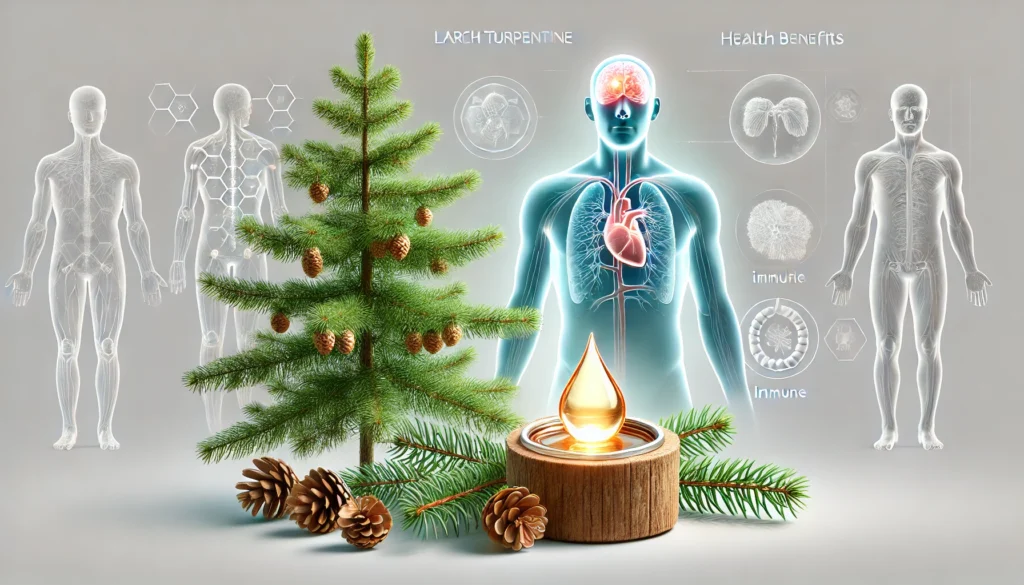Larch turpentine is a natural oleoresin extracted from the larch tree (Larix spp.), primarily Larix decidua and Larix sibirica. Traditionally used in folk medicine for its antiseptic, expectorant, and anti-inflammatory properties, larch turpentine is composed of a complex mixture of volatile terpenes, resin acids, and other bioactive compounds. Recent interest in its pharmacological potential suggests that certain constituents of larch turpentine may exhibit nootropic effects, influencing cognitive function through neuroprotective, anti-inflammatory, and circulatory-enhancing mechanisms.
This article explores the source, chemistry, physiological mechanisms, potential cognitive benefits, dosage guidelines, safety profile, and interactions of larch turpentine as a supplement. While not a conventional nootropic, its bioactive components—particularly monoterpenes, diterpenes, and sesquiterpenes—warrant scientific evaluation for potential neuroprotective and cognitive-enhancing properties.
You May Also Like:
Sources of Larch Turpentine
Larch turpentine is derived from the resinous sap of various Larix species, primarily harvested in Europe, Russia, and North America. Unlike pine turpentine, which is extracted from Pinus spp., larch turpentine has a distinct chemical profile, with a high concentration of pinenes, camphene, and other terpenoids.
The process of extracting larch turpentine involves tapping the bark of mature trees, allowing the oleoresin to exude naturally before being distilled into essential oil or purified for pharmaceutical and supplemental use. This crude resin contains volatile terpenes and resin acids, which contribute to its biological activity.
Larch turpentine is commonly available in:
- Essential oil form, often diluted for external or aromatic use
- Encapsulated resin extracts, standardized for terpene content
- Liquid resin preparations, used in traditional medicine for respiratory and circulatory support
Chemistry of Larch Turpentine
Larch turpentine consists of a complex mixture of monoterpenes, diterpenes, and resin acids, which contribute to its pharmacological activity and potential nootropic properties. The major bioactive compounds include:
1. Monoterpenes (Volatile Components)
These small, lipophilic molecules easily cross the blood-brain barrier, where they exert various neurological effects. Major monoterpenes found in larch turpentine include:
- α-Pinene and β-Pinene – Promote acetylcholine release, supporting memory and cognitive function
- Camphene – Exhibits antioxidant and anti-inflammatory activity, reducing neuroinflammation
- Limonene – May enhance dopaminergic signaling, improving mood and focus
2. Diterpenes and Sesquiterpenes
Larger terpenoid compounds in larch turpentine contribute to its immune-modulating and circulatory-enhancing effects, which may support cognitive function indirectly. Notable examples include:
- Labdane diterpenes – Exhibit neuroprotective and anti-inflammatory activity
- Cadinene sesquiterpenes – Promote cerebral blood flow, potentially enhancing cognitive performance
3. Resin Acids (Phenolic Derivatives)
Larch turpentine also contains abietic acid, dehydroabietic acid, and levopimaric acid, which have been studied for their anti-inflammatory and neuroprotective effects. These compounds may reduce oxidative stress and support neuronal health.

Physiological Mechanisms of Larch Turpentine in the Body and Brain
Larch turpentine exerts several physiological effects that may contribute to cognitive enhancement, including neuroprotection, anti-inflammatory activity, enhanced circulation, and neurotransmitter modulation.
1. Neuroprotection and Antioxidant Activity
The terpenes in larch turpentine have been shown to exhibit strong antioxidant properties, helping to neutralize free radicals and protect neurons from oxidative damage. This is particularly important for mitigating age-related cognitive decline and neurodegenerative disorders.
- α-Pinene and camphene help reduce oxidative stress in neural tissues, supporting memory retention and learning ability.
- Limonene may enhance mitochondrial function, which is critical for sustained cognitive energy.
2. Anti-Inflammatory and Immune-Modulating Effects
Chronic neuroinflammation is linked to cognitive impairment and neurodegenerative diseases. Larch turpentine has been found to inhibit pro-inflammatory cytokines, such as TNF-α and IL-6, which contribute to brain inflammation.
- Diterpenes and sesquiterpenes help regulate the immune response, potentially reducing inflammation in the central nervous system.
- Resin acids may modulate microglial activation, preventing excessive immune activity that can damage neurons.
3. Enhanced Cerebral Blood Flow
Larch turpentine’s vasodilatory effects may improve oxygen and nutrient delivery to the brain, promoting mental clarity and focus.
- Cadinene sesquiterpenes enhance endothelial function, potentially reducing cerebral hypoxia.
- Limonene and α-pinene have been associated with increased dopamine activity, which may improve motivation and alertness.
4. Neurotransmitter Modulation
Some monoterpenes in larch turpentine may interact with cholinergic and dopaminergic pathways, supporting memory, mood, and executive function.
- α-Pinene has been shown to enhance acetylcholine activity, which is critical for memory formation and cognitive flexibility.
- Limonene may promote dopamine release, supporting motivation and mental clarity.
Potential Nootropic Benefits of Larch Turpentine
Larch turpentine may provide several cognitive benefits, primarily through neuroprotection, neurotransmitter modulation, and enhanced circulation.
1. Improved Memory and Learning
Larch turpentine’s acetylcholine-enhancing effects may support working memory, recall, and learning capacity.
2. Enhanced Mental Clarity and Focus
The dopaminergic activity of limonene and pinenes may improve attention and cognitive endurance, making it beneficial for individuals experiencing brain fog or fatigue.
3. Protection Against Neurodegeneration
The antioxidant and anti-inflammatory properties of larch turpentine may help prevent or slow cognitive decline, particularly in neurodegenerative conditions like Alzheimer’s and Parkinson’s disease.
4. Mood Enhancement and Stress Reduction
Larch turpentine’s dopaminergic and cholinergic effects may contribute to mood stabilization and stress resilience, reducing mental fatigue and anxiety-related cognitive impairment.

Dosage and Supplementation Guidelines
Larch turpentine is primarily available in essential oil, resin extract, and encapsulated supplement forms. Dosage varies based on intended use and individual tolerance:
- General Cognitive Support: 50–100 mg of standardized extract per day
- Neuroprotection and Anti-Inflammatory Support: 100–250 mg per day
- For Aromatherapy (Inhalation Use): 2–4 drops diluted in a carrier oil
Larch turpentine should never be consumed undiluted in essential oil form due to potential toxicity risks.
Side Effects and Safety Considerations
Larch turpentine is generally well-tolerated when used within recommended doses. However, potential side effects include:
- Mild gastrointestinal discomfort (bloating, nausea)
- Allergic reactions in individuals sensitive to terpenes
- Potential liver and kidney toxicity at very high doses
Interactions with Other Supplements and Medications
1. Blood Thinners (Anticoagulants)
Larch turpentine may enhance blood-thinning effects, increasing the risk of bleeding when combined with warfarin or aspirin.
2. Central Nervous System Stimulants
Larch turpentine may potentiate stimulants like caffeine or amphetamines, leading to increased heart rate and nervousness.
3. Acetylcholinesterase Inhibitors
Because α-pinene enhances acetylcholine activity, it may interact with Alzheimer’s medications such as donepezil.
Conclusion: Should You Consider Larch Turpentine as a Nootropic?
Larch turpentine’s antioxidant, anti-inflammatory, circulatory, and neurotransmitter-modulating properties suggest that it may support cognitive function, particularly in memory enhancement, mental clarity, and neuroprotection. However, more clinical research is needed to confirm its nootropic efficacy. Individuals considering larch turpentine should consult a healthcare professional before supplementation, especially if taking medications or managing pre-existing health conditions.

References:
- Larch Turpentine – Uses, Side Effects, and More. Retrieved from: https://www.webmd.com/vitamins/ai/ingredientmono-629/larch-turpentine
- In Vitro Anti-inflammatory Effects of Larch Turpentine, Turpentine Oil, Eucalyptus Oil, and Their Mixture as Contained in a Marketed Ointment. Retrieved from: https://pmc.ncbi.nlm.nih.gov/articles/PMC11614573/
- The essential oil of turpentine and its major volatile fraction (α- and β-pinenes): A review. Retrieved from: https://www.researchgate.net/publication/41669083_The_essential_oil_of_turpentine_and_its_major_volatile_fraction_a-_and_b-pinenes_A_review
Important Note: The information contained in this article is for general informational purposes only, and should not be construed as health or medical advice, nor is it intended to diagnose, prevent, treat, or cure any disease or health condition. Before embarking on any diet, fitness regimen, or program of nutritional supplementation, it is advisable to consult your healthcare professional in order to determine its safety and probable efficacy in terms of your individual state of health.
Regarding Nutritional Supplements Or Other Non-Prescription Health Products: If any nutritional supplements or other non-prescription health products are mentioned in the foregoing article, any claims or statements made about them have not been evaluated by the U.S. Food and Drug Administration, and such nutritional supplements or other health products are not intended to diagnose, treat, cure, or prevent any disease.


